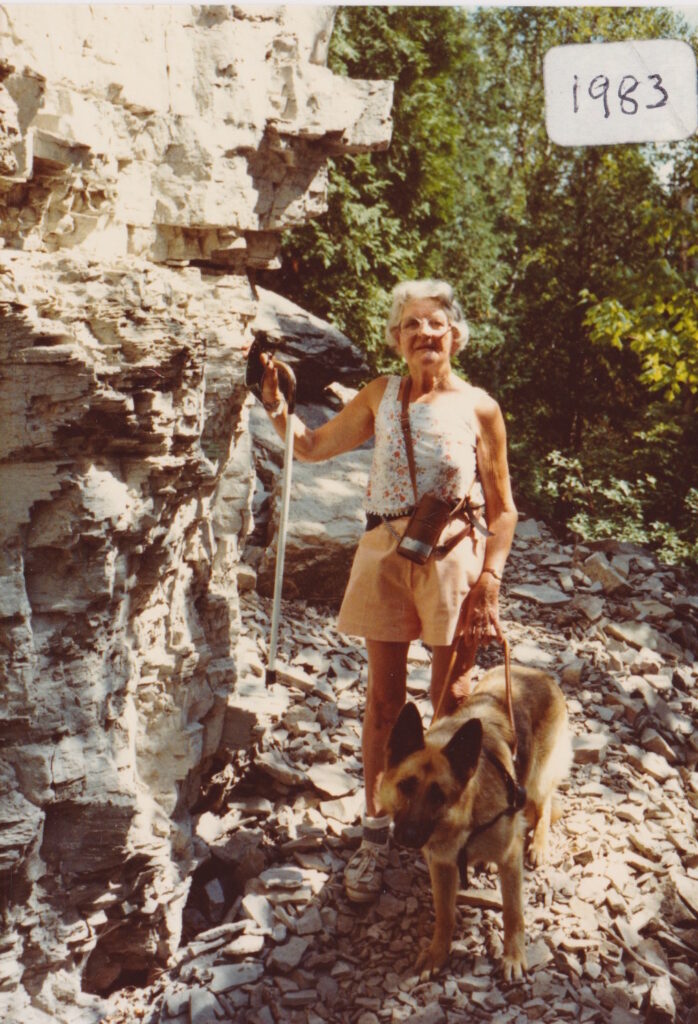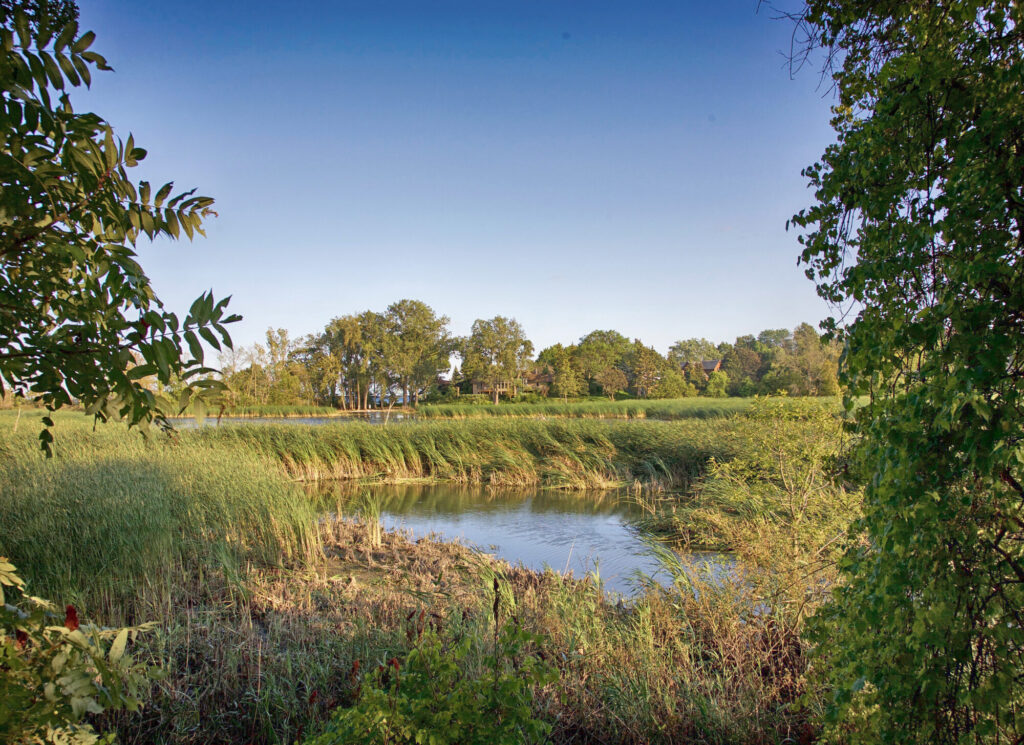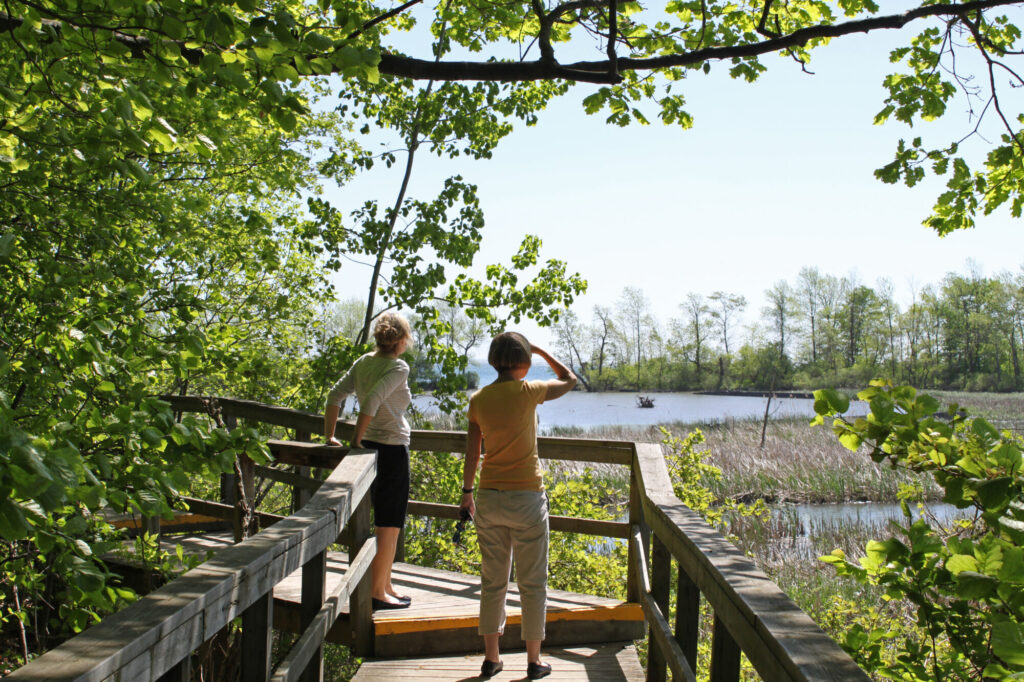Rattray Marsh is the last remaining wetland area on the western side of Lake Ontario, a testament to Ruth Hussey, the British-born veterinarian who blew into town with Hurricane Hazel.
The marsh sits on a 94-acre stretch of land along Lake Ontario in Clarkson. It includes a cobble beach, wetland, fields and woodlands – one of the last ‘shingle bar’ marshes along Lake Ontario.
In October 1954, Hurricane Hazel ravaged the shores of Ontario. Amidst the chaos, Ruth Hussey, accompanied by her three young boys, has just arrived from England.
Their journey to Clarkson was delayed due to the severe flooding on the Humber River. Bryan Hussey, Ruth’s husband, had come ahead in February and found work with British American Oil, securing a house on Meadow Wood Lane.
Little did anyone know that Ruth Hussey’s arrival would herald a different kind of whirlwind, one that would forever change the fate of Rattray Marsh.

Dr. Ruth Hussey on a hike in 1983. (Photo courtesy Mississauga’s Legends Row)
Hussey, a woman of small stature but immense conviction, was a master of many trades. She was a Scout and Cub leader, a gardener, a naturalist, a dog breeder, a church choir member, a hiker, a seniors’ fitness teacher, and even a veterinarian.
By 1956, the Hussey family had grown, moving to a new home at 1629 Watersedge Road, with Ruth’s passions now including activities as a hockey, rowing, riding, and track mom.
Their new house was near the Rattray Estate, where Major James Rattray generously allowed neighborhood children to use its sandy beach, play hockey on a protected pond, fish in the marsh, and ride his horses and pony.
When Major Rattray passed away in 1959, residents like the Husseys were concerned about the future of his 148-acre estate, comprising forest, farmland, beach frontage, and marshlands.
Strangely, despite his obvious love of the land and his willingness to share it with neighbours, Major Rattray’s will did not explicitly bequeath the land to anyone or any entity – and this is where Hussey stepped up.

Rattray Marsh today. (Photo courtesy City of Mississauga)
In the early 1960s, Ruth had read Rachel Carson’s, “Silent Spring,” which addressed the excessive use of pesticides and their environmental impact. For Ruth, the book was a call to arms. Alongside her husband Bryan and other community members, Ruth advocated for the purchase of Major Rattray’s property for a public park. However, their initial efforts were met with resistance, and the land was sold to developers in 1963.
The developers’ plans for luxury housing and a yacht basin faced fierce opposition from environmentalists, including the South Peel Naturalists’ Club.
Over the next 16 years conservationists and developers would battle over the fate of Rattray Marsh,
Hussey was among the most ardent of the Marsh’s protectors.
She and her husband Bryan worked with others to try and raise enough money to purchase the entire property and save it from development.
However Toronto Township Council wasn’t interested. In the mid-1960s the council approved the first phase of development and soon bulldozers could be heard near the marsh.
Heartbroken, Ruth refused to give up.
Then fate intervened. In January 1967 after reading an article in the Globe and Mail about land conservation, Ruth wrote an impassioned letter to the editor, detailing the many wonders of Rattray Marsh and why Clarkson residents deserved to have this unique watershed preserved and protected.
Something about that letter caught the public’s imagination and support started pouring in, leading to the formation of the Rattray Marsh Preservation Committee with Ruth as chair.
And like so many local advocacy groups have done, the Preservation Committee knocked on doors and spoke with neighbours, collecting 2,000 signatures and countless letters in support of preservation, which they presented to Toronto Township Council…who promptly ignored them.
The pull of increased tax revenue and population growth held a stronger appeal than protecting marshland for birds, frogs and foxes.
However, the tide began to turn in 1974.

Visitors enjoy the view of Lake Ontario at Rattray Marsh. (Photo courtesy City of Mississauga)
First, Ruth received the Carl Nunn Media Conservation Award from the Federation of Ontario Naturalists, officially recognizing her commitment to the marsh and elevating her profile.
Also that year, the City of Mississauga was created, electing a new council that included Marsh advocates, including a councillor from Streetsville – Hazel McCallion.
A deal was struck: the City would agree to preserve the Marsh if Ruth and the Preservation Committee could raise enough money to match the City’s contribution.
No problem, said Ruth – and it wasn’t.
Rattray Marsh officially opened to the public the next year.
For the final 10 years of her life, Hussey was able to enjoy the fruits of her labour, walking through the Marshland she found so hard to save.
Today you can enjoy Rattray Marsh on its own or as a part of The Great Lakes Waterfront Trail, which travels 325 kilometres between Trenton and Hamilton.
Rattray Marsh is managed by Credit Valley Conservation and can be accessed via Jack Darling Park at Turtle Creek. It is the single busiest access point in Credit Valley Conservation’s entire system, welcoming over 300,000 visitors each year.
At the western end of Rattray, near the entrance on Old Poplar Row in the neighbourhood where Hussey lived, you’ll find a large stone that simply says “Ruth Hussey: Because of her, Rattray Marsh is ours.”
You can hear more stories about the people and events that helped shape Mississauga via our podcast, We Built This City: Tales of Mississauga, available on your favourite podcast platform or from our website.
